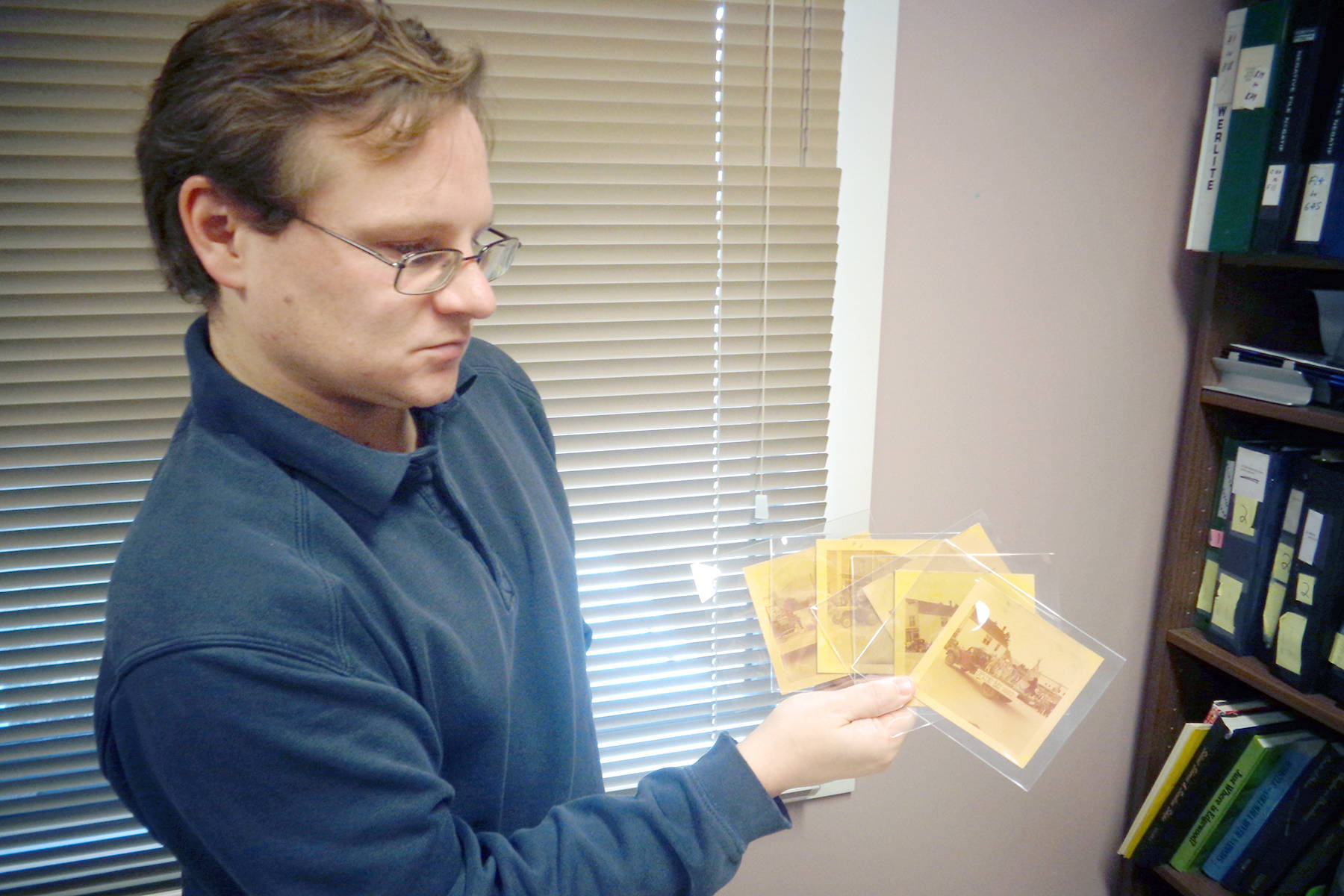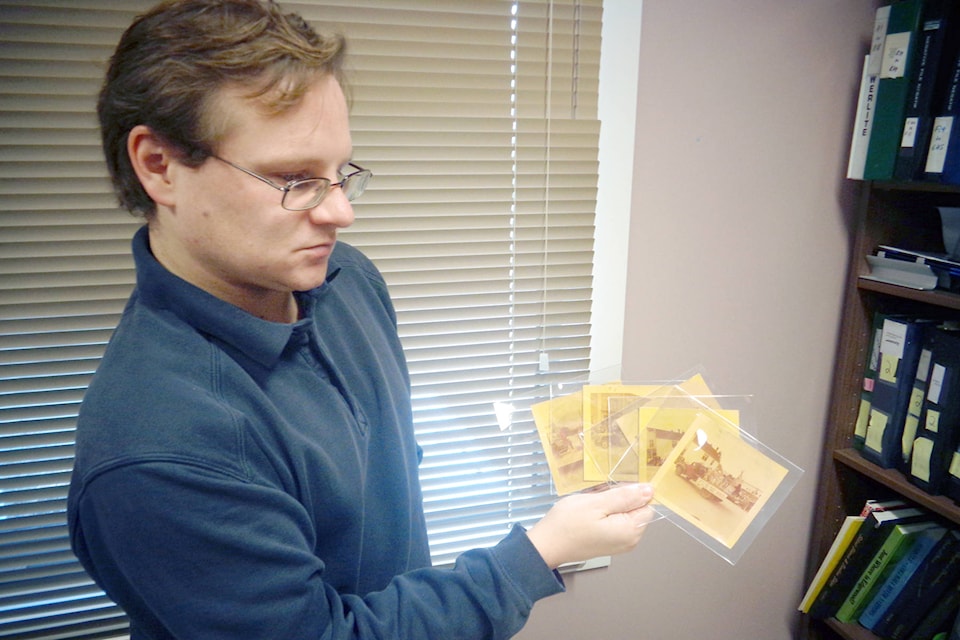All Kyle Kusch wants for Christmas is about 900 scanned photos.
“I’m at 14,100 digitized,” says the archival technician with the Arrow Lakes Historical Society. “I have about four weeks to meet our 15,000 goal.”
Kusch is on the last stretch of the third phase of a program to convert slides, negatives and old photographs of Nakusp and area into digital images and put them on the internet. The project is being funded with $17,000 from Library and Archives Canada, a program of the federal government.
It’s a job that began in 2016, and while this third phase of the project is almost done, much remains unfinished.
“I will never truly know how much there is to do,” he said. “There are about 30,000 photos. I have about 10,000 negatives in my office, and then the filing cabinets, those are all physical photos. And once that’s done — more are coming in constantly.”
The scanning project is taking these rare and often obscure photos of the village’s past and, by putting them online, making them available for everyone to see and far easier to purchase. And by offering them up for sale, it’s developed a new revenue stream for the tiny archive. Visitors can use a search engine on the Society’s page to find pictures of family, old landmarks or events in the community dating back to the turn of the 20th century.
https://alhs-archives.com/
Kusch says the project is growing even as he works to digitize the collection the archives has now.
“Somebody will come in and may have a handful of family photos. Then a couple of weeks later someone will come in and say, ‘our business is closing would you like to preserve the records?’ Then a few albums will be dropped off, and there’s another 400 photos that have to be dealt with.”
And it’s not just scanning that takes time. Every photo needs to be linked with searchable information. And since this is history, you have to be sure it’s right.
“I have to double-check everything. About 10 per cent of my job is correcting the information on photos. And every time you get a new batch, that informs the other photos you have. Sometimes you’ll find that information doesn’t match up, and you have to cross check. That takes a lot of time.”
It’s a job Kusch says he takes pretty seriously.
“You feel the weight of responsibility because you’re the only one with access to all this stuff every day,” he told Arrow Lakes News. “You are constantly on guard to preserve it. You have a duty to ensure every piece of information put out is as close to the truth as you can get. And that’s the problem; you’re always finding stuff that contradicts other information.”
Not everything Kusch scans and records get made public. Some are just poor quality; others can’t be used because of copyright- anything before 1948 is public, but other copyright rules govern more recent materials. Then there are privacy concerns, as some photos show people who are still around today.
And then there some photos that are just inappropriate.
“When you see drama clubs from the 1950s putting on plays called ‘Teen Tune Darkies’ and it’s like ‘ewww’,” he recalled. “In the meantime, you, think about what took place in the States in the 50s, and here’s the newspaper clippings talking about “using authentic darkie slang”. It’s disheartening.”
But at the same time Kusch, who grew up in Nakusp, says you can watch the community change quickly for the better as the years pass.
“Nakusp was a couple of decades behind culturally until the 1960s, then things changed, and you see how things really changed,” he says. “There was an absolute culture war — people talking about unkempt, unruly anarchists coming here in the mid-60s, then by the late 70s it’s ‘meh’ — they’re not even thinking twice about it.”
But while Kusch says he finds some of the attitudes of the past “appalling,” he finds other stories inspiring, or bittersweet. One chapter of the community’s history that he found especially touching, and rewarding to rediscover, is the flooding of the valley in the ‘60s.
“If you were born here, after say 1966, you don’t remember life without the dams, you don’t know what it was like to have an almost unbroken stream of communities from here to Edgewood,” he said.
“Now through this project, you can show people it’s not a myth, it’s not just what your parents told you. Here’s the evidence, here’s what they looked like, these towns that aren’t here anymore, the 2,100 people having their livelihoods stripped from them.”
He says it’s especially important to get that era documented while the living memory is still with us.
“People don’t realize how much access they have to this stuff, that their parents and grandparents are still around and remember that stuff. Which is why the next 20 years are so huge to document those things.”
Kusch encourages anyone in Nakusp with old family photos or a unique story to tell with pictures to drop by the archives to have them included in the collection.
“If you don’t see much of your family, or your business, or anything relevant to you in the archives, don’t hesitate to bring your photos in,” he said.
“I want people to know their history matters. Everyone who has ever lived here has a story to tell, and everyone has value.”
While he has 15,000 photos nearly complete, and 15,000 more to do, his enthusiasm isn’t diminished.
“When people come in and look up family and friends, you can see their eyes widen and I say, “hey, I made an impact!”.
“Every single family has a story to tell, and I would hate for anybody’s story not to be told.”
@boivinnews
reporter@arrowlakesnews.com
Like us on Facebook and follow us on Twitter

